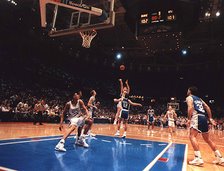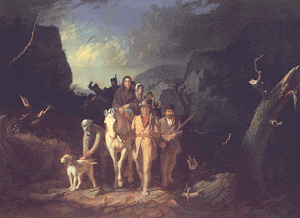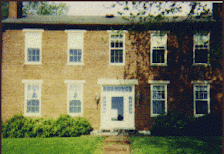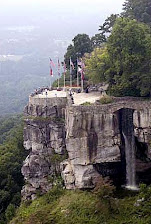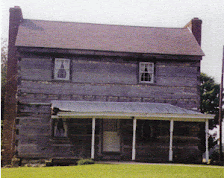I left off with a planned coffee visit with Preston as he was arriving to Washington very close to the hour I was departing. We ended up meeting at a coffee shop just south of Dupont Circle on 19th Street NW. I waited for him as he was arriving from the Metro Red Line and there was an up-escalator there on 19th where I could see him as he arrived. We chatted for about 40 minutes, mostly on political economy and philosophy, with very little actual discussion about Democrats or Republican or Independents. Playing drums in the background over in Dupont Circle was the all-female percussion group Batala - visit their website at batalawashington.com. They had been practicing for at least an hour before Preston arrived and were still playing as we departed.
 My car was parked around the corner in front of the Honk Kong Trade Office (shown at left) at 18th and Church streets NW. From there I left for New York City, the Big Apple, the City that Never Sleeps, the city So Nice they named it twice. While my stay in Washington was a combination of business and pleasure, the trip to New York had the sole purpose of helping a friend of mine move from an apartment in the Bronx to another one in Brooklyn, and then to bring him back to Louisville to witness his brother's graduation from Ballard High School which took place last night. When he found out I was to be in washington he suggested that "while I was in the neighborhood" I could give him a ride back to Louisville. His moving from the Bronx to Brooklyn was never a part of the "no-plans" vacation, but it did become so.
My car was parked around the corner in front of the Honk Kong Trade Office (shown at left) at 18th and Church streets NW. From there I left for New York City, the Big Apple, the City that Never Sleeps, the city So Nice they named it twice. While my stay in Washington was a combination of business and pleasure, the trip to New York had the sole purpose of helping a friend of mine move from an apartment in the Bronx to another one in Brooklyn, and then to bring him back to Louisville to witness his brother's graduation from Ballard High School which took place last night. When he found out I was to be in washington he suggested that "while I was in the neighborhood" I could give him a ride back to Louisville. His moving from the Bronx to Brooklyn was never a part of the "no-plans" vacation, but it did become so.
 Thus I left from DC along the I-95 corridor which would take me to Baltimore and points to the northeast. Somewhere outside of Batlimore I stopped at a rest areas where a Boy Scout Troop (and their parents) were serving coffee, lemonade, and hot dogs. While they weren't charging, buckets were available for donations and I made mine. I passed through (and literally under) Baltimore Harbor on I-895 before returning to the parent route en route to Delaware. As I recall there were two tolls booths along the short route of I-95 in Delaware. In New Jersey, you are somewhat force-fed onto the New Jersy Turnpike, and another toll road. Tolls were about to become a big part of my trip.
Thus I left from DC along the I-95 corridor which would take me to Baltimore and points to the northeast. Somewhere outside of Batlimore I stopped at a rest areas where a Boy Scout Troop (and their parents) were serving coffee, lemonade, and hot dogs. While they weren't charging, buckets were available for donations and I made mine. I passed through (and literally under) Baltimore Harbor on I-895 before returning to the parent route en route to Delaware. As I recall there were two tolls booths along the short route of I-95 in Delaware. In New Jersey, you are somewhat force-fed onto the New Jersy Turnpike, and another toll road. Tolls were about to become a big part of my trip.
Riding along the New Jersey Turnpike is, frankly, boring. It is a four to six lane divided highway with groves of trees along both sides, devoid of anything other than concrete and cars. There were maybe six intersections along the entire route. You get a toll-ticket as you enter the turnpike and there are toll booths along each exit. I drove the entire length of the turnpike, all the way to my destination in Little Ferry, just across the Hackensack River from New York on US46. My toll for the privelege of travelling the entire distance was $9.05.
I haven't much to say about my non-tourist visit to New York City. It was mostly spent on interstates and freeways, with regular stops at toll booths to pay very high tolls, anywhere from $3.00 to $11.00 for the privelege of being in one or more of New York's five boroughs. And, getting around by car wasn't made any easier by my friend.
 Keith doesn't own a car and doesn't seem to need one. He lived in the Bronx and worked in Lower Manhattan. He now lives in Brooklyn. All of these points are connected by busses, trains, and subways, and Keith's directions to and from anywhere are mired in subway stations, transfer points, and bus-stops. Unfortunately he couldn't tell me exactly how to get around in a car other than if one was close to the Brooklyn Bridge, shown at right. From sighting the bridge Keith could easily get you into Brooklyn or out of Manhattan. In Manhattan it is easy - most of the streets are numbered and the whole affair isn't all that wide. The Bronx continues the numbered street system of Manhattan which makes it a little easy. All the other boroughs have their own sets of numbered streets along with a collection of Broadways, Parks, Markets, and Mains. Keeping them all straight requires some concentration.
Keith doesn't own a car and doesn't seem to need one. He lived in the Bronx and worked in Lower Manhattan. He now lives in Brooklyn. All of these points are connected by busses, trains, and subways, and Keith's directions to and from anywhere are mired in subway stations, transfer points, and bus-stops. Unfortunately he couldn't tell me exactly how to get around in a car other than if one was close to the Brooklyn Bridge, shown at right. From sighting the bridge Keith could easily get you into Brooklyn or out of Manhattan. In Manhattan it is easy - most of the streets are numbered and the whole affair isn't all that wide. The Bronx continues the numbered street system of Manhattan which makes it a little easy. All the other boroughs have their own sets of numbered streets along with a collection of Broadways, Parks, Markets, and Mains. Keeping them all straight requires some concentration.
Given that I was in and out of New York in 36 hours, I tried to go as many different ways as I could between his two apartments, one on 238th Street in the Bronx, the other on DeKalb Avenue in Brooklyn. Along the ways, I may as well have travelled to others countries as I drove through areas wholly occupied by people speaking Spanish or Polish or Arabic or something else. Latinos seem to outnumber everyone else. for a while I was in an Hasidic Jewish neighborhood in Williamsburg, this on a Saturday night with everyone in their synagogue-going best. It was quite an experience.
But the whole New York thing was overwhelming - too much humanity for me. I cannot imagine existing everyday amongst so many people. Thus, there was no sorrow when the time came to leave the Big Apple and return to the relative southern comfort of America's biggest little town, Louisville.
One place I had never been was Staten Island, so the trip out of New York took us across the Verrazano-Narrows Bridge, America's largest suspension bridge, from Brooklyn onto Staten Island (also the name of the borough) and into the County of Richmond. Crossing the bridge brought the highest toll I paid anywhere on the trip - $11.00. I'm not sure that my $11.00 bought me $11.00 worth of goods, but it was a place I had never been before and one of the great points of driving anywhere is to visit places theretofore unvisited.

We left Staten Island and ventured northward up to Hackensack, NJ and Interstate 80. I-80 would take us across northern New Jersey, through the Delaware Valley Water Gap and into the mountains of central Pennsylvania. At another rest area we encountered more Boys Scouts doling out hot dogs and soft drinks. This time we could add chili and sauerkraut. I had one of each and made a hefty donation.
Midway across the state, we left Interstate 80 headed for Interstate 99, the highest numbered two-digit interstate. I-99 is unusual in a number of ways. First, it should not be in central Pennsylvania. I do not know what the highway located east of I-79 and west of I-81 should be numbered, but I-99 should certainly be somewhere along the eastern seaboard. But, it isn't. It is also odd in that it physically begins as PA26, a two-lane state highway. PA26 picks up US220 and then becomes I-99. Similarly, at its end, it goes back to US220. Very few interstates do not begin or end at another interstate and only 15 lay wholly within one state. I-99 takes you through rolling hills and valleys, running closeby State College, home to Penn State University.
 At the end of I-99 we continued south on US220 the handful of miles left between the town of Bedford and the Maryland border, the very well-known Mason-Dixon line, or properly, Mason's and Dixon's line, the symbolic boundary between the North and the South. US220 leads into the very historic town of Cumberland, Maryland. Cumberland is a city full of church steeples, and the city itself is steeped in the history of our republic, established long before the Revolution. Because of its site on a river, canal, and rail line, it, like Louisville, grew as a transportation hub and at one time this little town stretched along the banks of the Upper Potomac River and Wills Creek was Maryland's second largest city. It is sometimes known as Maryland's Queen City.
At the end of I-99 we continued south on US220 the handful of miles left between the town of Bedford and the Maryland border, the very well-known Mason-Dixon line, or properly, Mason's and Dixon's line, the symbolic boundary between the North and the South. US220 leads into the very historic town of Cumberland, Maryland. Cumberland is a city full of church steeples, and the city itself is steeped in the history of our republic, established long before the Revolution. Because of its site on a river, canal, and rail line, it, like Louisville, grew as a transportation hub and at one time this little town stretched along the banks of the Upper Potomac River and Wills Creek was Maryland's second largest city. It is sometimes known as Maryland's Queen City.
From Cumberland it is only a small stretch along Interstate 68, formerly known as US48 over to the West Virginia state line (and therein lies a story from 1981 about a certain KYD/YDA convention, former KYD president Bobby Rowe, and me and John Warren McCauley, perhaps somewhat intoxicated, giving bad directions to a lost Morehead State University bus driver). But, I digress.
Arriving in West Virginia, I-68 comes to an end and I-79 is the southbound interstate which takes you up and down and over and across the hills and valleys of central West Virginia. While it is a well-built highway, the path it follows - the only path it could follow - leaves much to be desired. Being quite familiar with this stretch of road, I turned the driving over to one of my fellow travellers, took to the back seat and woke up, thankfully, in Kentucky. Thus, I missed Clarksburg, Charleston, and Huntington.
The final leg of the 2185 mile trip was along I-64 from Catlettsburg and Cannonsburg in Boyd County across the center of the Commonwealth. It was longer than usual because we were all tired and at this point, it was the middle of the night. We stopped alot mostly to wake up and drive a few more miles. I remember stretching out of the grass for a catnap at the rest area between Lexington and Frankfort, something I had not done since I was a UK student back in the late 1970s.
At some point around 4:15 am, we exitted I-64 onto Mellwood Avenue, then north on Frankfort, and west on Story making our way back home. It was a wonderful trip.








